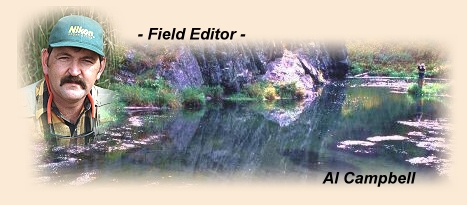|
No, the title isn't talking about the declining length of
my arms. Yes, my age is advancing as fast as my ability to
focus on close items is declining. However, I'm not talking
about that type of vision. The vision I'm talking about is
a certain type of vision that relies more on the mind than
the eyes.
Several people have e-mailed me asking why I ended the Advanced
Fly Tying series so soon. The answer is; I didn't end it, but
rather took a break. As some of you know, I have been in the
middle of a major remodeling project for some time now, and my
fly tying area has been buried so far under "stuff" that I
couldn't get to it. The project is still in progress, but I
recently "discovered" my fly tying bench and about half of my
supplies.
I have another problem too. Several of the flies I want to show
don't seem to be cooperating with my camera skills. Getting the
right lighting and angles to show the steps has (so far) eluded
me. It's one thing to tie a fly, and something totally different
to photograph the details. Many of the steps you see on the
screen require odd camera angles or tilting the vise a certain
way to get the right light on the area of the fly that needs to
be shown. Sometimes I just need another set of hands.
I would like to focus your attention on the Atlantic Fly Tying
series that Ronn Lucas and friends are doing. Some of the skills
you see there are far beyond intermediate. That is an area of
fly tying that I haven't spent a lot of time in. With their
guidance, I'm going to be learning along with you. This is fun.
Next week, I'll be adding another pattern to my advanced series.
I'll do that occasionally as time and overcoming
photography problems allows. Maybe I should say, I'll do that
as often as the "honey-do list" allows, but that's only part of
the delay.
When you venture into the dark realm of advanced techniques, a
lot of focus is placed on doing things differently; or should I say,
seeing things differently? This area of tying is as much about
finding new ways of doing old things as it is about conquering
tough techniques. Sometimes the techniques are simple enough,
but the focus or ideas are new. It might be keying in on what
makes a fly attractive to the fish, or just finding a new way
to conquer an old problem. It's the art of focussing on an old
problem with new vision.
When a person truly advances from the intermediate level to the
advanced level of tying, he/she has developed a type of vision
that permits the mental dissecting of a fly to see what makes
it work or what makes it attractive to the fish. At that point,
he/she can focus on and enhance the key properties of the fly
to make it more attractive to the fish it was designed to attract.
Once you reach that point, there are few boundaries left to hold
you back.
How is it that a crazy guy from South Dakota could design a fly
for a saltwater species of fish he had never caught? And, how
is it that he could be so confident that the fly would be
successful that he tied several hundred of those flies in
several variations before he left to chase those fish? Why
could he predict that the fly would be successful, and watch
the prediction come true? The answer is vision.
The vision I'm referring to is the ability to key in on the
most attractive qualities of any pattern and either enhance
those qualities in a similar pattern, or place them in a new
pattern in such a manner that they will be more attractive to
the fish. Maybe the attraction is a certain type of flash,
or maybe a key profile. Maybe the attractive quality is the
way a fly moves in the water, or maybe it's the way it doesn't
move. To make improvements, you need to know what it is that
makes a certain fly attractive to a fish.
You've made it this far, so showing you something new is only
the beginning of possibilities, if you have the vision I'm
talking about. For instance, why hasn't somebody designed a
shrimp pattern that incorporates a keying feature that attracts
fish who usually feed on crabs? Are those types of flies too
far apart to be combined into a fly that works both ways? If
you were able to combine those two styles, what would the
offspring look like? Do you have the vision to make it work?
Fly tying is at least as much about mental coordination as it
is about teaching your hands to do what you want them to do.
When you advance beyond the realm of copying somebody else's
work into the area of designing flies that you know are going
to work even if they haven't been tested, you have stepped
across the threshold that separates the intermediate from
the advanced.
Do you have that vision? Are you able to see things differently?
If you do, there are no boundaries left to hold you back.
~ AC
|



